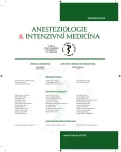Capillary electrophoretic method for formic acidmeasurement after methanol poisoning – casereport
Authors:
Bocek Robert 1; Kubáň Petr 2; Foret František 2; Gabzdylová Miroslava 3
Authors‘ workplace:
Anesteziologicko-resuscitační oddělení, Nemocnice s poliklinikou Havířov
1; Skupina bioanalytické instrumentace, Středoevropský technologický institut – Masarykova univerzita, Brno
2; Oddělení klinické biochemie, Nemocnice s poliklinikou Havířov
3
Published in:
Anest. intenziv. Med., 24, 2013, č. 5, s. 326-331
Category:
Intesive Care Medicine - Case Report
Overview
Methanol intoxication can be difficult to diagnose, especially if there is no supporting evidence of ingestion of the toxic compound. At the begining of the methanol intoxication epidemic in the Czech Republic (2012) we faced a negative anamnesis of alcohol consumption several times. The measured levels of methanol in these patients were very low, sometimes methanol was even not detected. The patients were suffering from concomitant illnesses and some of them had to be resuscitated during admission. Simple screening methods able to detect formic acid were not available at the beginning of the epidemic. Eventually, methanol intoxication was confirmed a few days later in a specialized toxicological laboratory. Therefore, we tested a novel capillary electrophoretic method for the rapid screening of concentration of formic acid in the serum above its normal physiological range. Analysis of the serum of the patients intoxicated with methanol proved that monitoring of formate concentration in the serum with the newly developed method before and during the medical management is possible.
Keywords:
methanol – formic acid – acidosis – capillary electrophoresis – haemodialysis
Sources
1. Becker, C. E. Methanol poisoning. The Journal of Emergency Medicine, 1983, 1, p. 51–58.
2. Kruse, J. A. Methanol poisoning. Intensive Care Med., 1992, 18, p. 391–397.
3. Kute, V. B., Godara, S. M., Shah, P. R., Gumber, M. R., Goplani, K. R., Vanika, A. V., Munjappa, B. C., Patel, H. V., Trivedi, H. L. Hemodialysis for methyl alcohol poisoning: A single-center experience. Saudi Journal of Kidney Diseases and Transplantation. 2012, 23, p. 37–43.
4. Jacobsen, D., Hovda, K. E. Methanol, ethylene glycol, and other toxic alcohols. In: Shannon, M. W., Borron, S. W., Burns, M. J. eds. Haddad and Winchester‘s Clinical Management of Poisoning and Drug Overdose. 4th ed. Philadelphia: Saunders Elsevier, 2007, p. 605–611.
5. Barceloux, D. G., Bond, G. R., Krenzelok, E. P., Cooper, H., Vale, J. A. American Academy of Clinical Toxicology Practice Guidelines on the Treatment of Methanol Poisoning. J. Clin. Toxicol., 2002, 40, p. 415–446.
6. Ševela, K., Ševčík, P., Kraus, R. Akutní intoxikace v intenzivní medicíně, Praha: Grada Publishing, 2002, 248 s. ISBN 80-7169-843-1.
7. Verhelst, D., Moulin, P., Haufroid, V., Wittebole, X., Jadoul, M., Hantson, P. Acute renal injury following methanol poisoning: analysis of a case series. Int. J. Toxicol., 2004, 23, 4, p. 267–273.
8. Hanzlik, R. P., Fowler, S. C., Eells, J. T. Absorption and elimination of formate following oral administration of calcium formate in female human subjects. Drug Metab. Dispos. 2005, 33, p. 282–286.
9. Westphal, F., Rochholz, G., Ritz-Timme, S., Bilzer, N., Schutz, H. W.,Kattsch, H. Fatal intoxication with a decalcifying agent containing formic acid. Int. J. Legal Med., 2001, 114, 3, p. 181–185.
10. Mahieu, P., Hassoun, A., Lauwerys, R. Predictors of Methanol Intoxication with Unfavourable Outcome. Hum. Toxicol., 1989, 8, p. 135–137.
11. Tanaka, E., Honda, K., Horiguchi, H., Misawa, S. Postmortem determination of the biological distribution of formic acid in me-thanol intoxication. J. Forensic Sci., 1991, 36, 3, p. 936–938.
12. www.tis-cz.cz
13. Kubáň, P., Foret, F., Bocek, R. Capillary electrophoresis with contactless conductometric detection for rapid screening of formate in blood serum after methanol intoxication. J. Chromatogr. A., 2013, 1281, p. 142–147.
14. Dostál, P. Léčba intoxikací kontinuálními eliminačními metodami. In Novák, I., Matějovič, M., Černý, V. et al. Akutní selhání ledvin. Praha: Maxdorf, 2008, p. 123-128.
15. Peces, R., González, E., Olivas, E., Reniel, F., Costero, O., Montero, A., Salgas, R., Fernández, R., Jiménez, M., Peces, C. Effectiveness of pre-emptive hemodialysis with high-flux membranes for the treatment of life-threatening alcohol poisoning. Nefrologia, 2008, 28, 4, p. 413–418.
16. Wallage, H. R., Watterson, J. H. Formic acid and methanol concentrations in death investigations. J. Anal. Toxicol., 2008, 32, 3, p. 241–247.
17. Rasanen, I., Viinamaki, J., Vuori, E., Ojanpera, I. Headspace In-Tube Extraction Gas Chromatography-Mass Spectrometry for the Analysis of Hydroxylic Methyl-Derivatized and Volatile Organic Compounds in Blood and Urine. J. Anal. Toxicol., 2010, 34, p. 113–121.
18. http://www.roche-diagnostics.cz/download/la/0113/kyselina_mravenci_FNBrno_LA01-2013.pdf
Labels
Anaesthesiology, Resuscitation and Inten Intensive Care MedicineArticle was published in
Anaesthesiology and Intensive Care Medicine

2013 Issue 5
Most read in this issue
- Multiple organ dysfunction syndrome
-
Skórovací schémata hodnocení sedace a výskytu deliria
I. Přehled skórovacích systémů hloubky sedace na JIP - Pre-eclampsia, eclampsia and HELLP syndrome from the anaesthesiologist’s perspective
- Ultrasound assessment during admission of trauma and shocked patiens (FAST)
